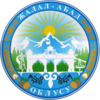|
Jalal-Abad Region
Jalal-Abad Region (/dʒəˈlɑːl əˈbɑːd/; Kyrgyz: [dʑɑˌɫɑɫ‿ɑˈβɑt]) is a region (oblus) of Kyrgyzstan. Its capital is the city of the same name, Jalal-Abad. It is surrounded by (clockwise from the north) Talas Region, Chüy Region, Naryn Region, Osh Region, and Uzbekistan. Jalal-Abad Region was established on 21 November 1939. On 27 January 1959 it became a part of Osh Region, but regained its old status as a region on 14 December 1990. Its total area is 32,418 km2 (12,517 sq mi).[2] The resident population of the region was 1,260,617 as of January 2021.[1] The region has a sizeable Uzbek (24.8% in 2009) minority.[2] GeographyJalal-Abad Region covers 32,418 km2 (12,517 sq mi) (16.2% of total country's area) in central-western Kyrgyzstan. The southern edge of the region is part of the Ferghana Valley. The rest of the region is mountainous. M41, the main north-south highway from Bishkek to Osh, takes a very crooked route down the center of the region. Another road follows the south border almost to the western tip and then turns northeast up the Chatkal valley to Kyzyl-Adyr in Talas Region. Another road (closed in winter and requiring a jeep from the Ferghana range to Kazarman) goes east to Kazarman and Naryn. An integral part of the country's power system is Toktogul hydroelectric power station, which supplies electricity and water to both Kyrgyzstan and neighboring countries. Ecology and environmentThe area has several mountain lakes, walnut forests, and mineral waters. It has also the world's largest natural growing walnut forest, called Arslanbob, about 40 kilometres (25 mi) north of Jalal-Abad city. Jalal-Abad Region is rich in ecological resources. Strictly protected areas (IUCN category Ia) located in the region are Sary-Chelek, Besh-Aral, Dashman and Padysha-Ata. There are three nature parks (IUCN category II): Alatay, Kan-Achuu and Saymaluu-Tash.[3] Natural monuments (IUCN category III) include: Tegerek Waterfall located in the upper reaches of the river Kara-Üngkür, Sogon-Tash Cave, and the Kara-Jygach Rocks, composed of red sandstone, in Aksy District. Among other protected areas are:
DivisionsThe Jalal-Abad Region is divided administratively into five cities of regional significance (Jalal-Abad, Kara-Köl, Kök-Janggak, Mayluu-Suu and Tash-Kömür) and eight districts:[4] Bazar-Korgon, Kerben, Kochkor-Ata and Toktogul are cities of district significance. There are four urban-type settlements in the region: Kyzyl-Jar and Shamaldy-Say (part of Tash-Kömür), Kök-Tash (part of Mayluu-Suu) and Ketmen-Töbö (part of Kara-Köl).[4] EconomyBasic socio-economic indicatorsThe economically active population of Jalal-Abad Region in 2009 was 440,804, of which 401,328 employed and 39,476 (9.0%) unemployed.[2]
EconomyWheat, fruit, vegetables, maize, nuts, tobacco, and silk-worm cocoons are grown in the region. The region also has a few textile plants and hydroelectric stations. Minerals, natural gas, coal, metals, and oil can be found here, notably around the town of Kochkor-Ata, which is home to small scale oil industry. Most of the extraction of minerals, natural gas, coal, metals, and oil of the Soviet era has ceased.  A pearl of the region is the Sary-Chelek Nature Reserve with Lake Sary-Chelek, surrounded by wild fruit orchards and snow-covered peaks. A few Soviet-era resorts offer mineral water treatment programs for people with various chronic diseases. A number of companies have succeeded in trading bottled mineral water around the country and abroad. Except for the small fringes of the Fergana Valley, Jalal-Abad Region is a land of mountains. There are unlimited trekking possibilities in the area, but the lack of infrastructure, except at Arslanbob, poses problems to visitors; a biodiversity conservation program supported by the government and the Global Environment Facility (GEF) is working to protect these natural resources and promote soft tourism. DemographicsThe population of Jalal-Abad Region, according to the Population and Housing Census of 2009, amounted to 930,630 (enumerated de facto population) or 1,009,889 (de jure population).[2] The official population estimate for the beginning of 2021 was 1,260,617.[1]
Ethnic compositionAccording to the 2009 Census, the ethnic composition of Zhalal-Abad Region (de jure population) was:[2]
References
|
|||||||||||||||||||||||||||||||||||||||||||||||||||||||||||||||||||||||||||||||||||||||||||||||||||||||||













